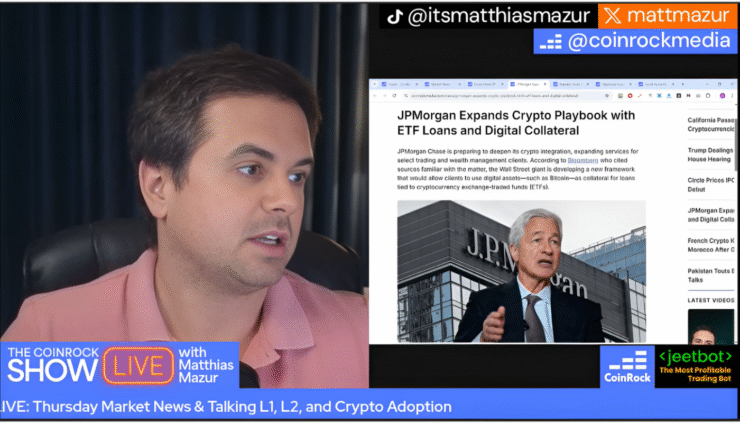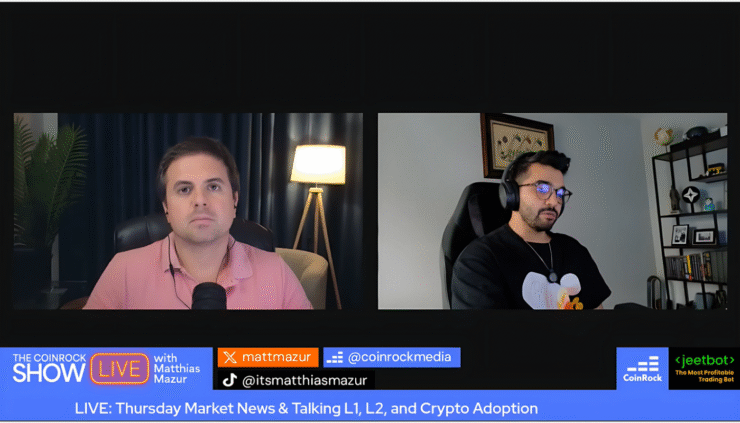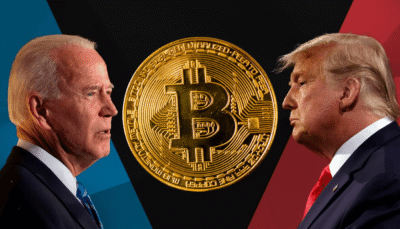As the crypto market inches closer to mainstream relevance, one of the most pressing questions remains: how do we bridge the gap between traditional finance and decentralized systems? This week’s episode of The CoinRock Show features Deniz Dalkilic — co-founder of Lumia and a blockchain architect with over a decade of engineering experience — who makes the case for why Real-World Assets (RWAs) may hold the key.
But before diving into Lumia’s vision and the RWA thesis, the episode opens with a snapshot of the week’s macro trends. Bitcoin briefly dipped below $105K amid minor ETF outflows, while altcoins like SOL and TON saw a modest recovery. Meanwhile, regulatory developments in Europe hint at an upcoming MiCA update — a reminder that real-world clarity is slowly catching up to real-world tokens.
Matthias also took out time to talk about the impact of the Feds decision on market movement:
“I’m surprised by how strong Powell has been so far.” he said
“I wrote an article back in January, February about folding under pressure. So far, Jerome Powell is not folding under any pressure. So it’ll be very interesting.”

Who is Deniz Dalkilic?
Deniz Dalkilic isn’t just another founder riding the tokenization wave — he’s one of the infrastructure purists helping shape the backend stack of Web3. With over 10 years of full-stack development and Web2 backend experience, Deniz has transitioned smoothly into architecting smart contract systems, decentralized protocols, and now Layer-2 rollups. His most recent venture, Lumia, is a modular RWA-centric Layer-2 chain designed to make real-world financial products and assets blockchain-native.
Deniz Dalkilic’s crypto journey spans more than a decade, starting long before the current RWA hype cycle. With a background in full-stack engineering, Deniz has spent years building infrastructure across L1s, L2s, and dApps, navigating the pain points of Web3 from both technical and strategic angles.
“I started out as a software engineer,” he said
“Then I came across Ethereum, I came across blockchain and Bitcoin, and then I immediately actually left the company about a month after finding out. I tend to, you know, enjoy the technical aspects of development.”
Now, as co-founder of Lumia, Deniz is tackling one of the most ambitious problems in crypto: building a permissionless infrastructure for real-world asset issuance and trading that scales across multiple ecosystems.
Why RWAs Are the Real Trojan Horse
Deniz believes that the next phase of crypto adoption won’t come from degen farming or meme coin speculation — it’ll come from institutional flows enabled by real-world assets like treasuries, invoices, real estate, and carbon credits.
“We try to find opportunities where we can optimize and improve what’s already out there so that we can actually truly offer something that’s needed in the space as opposed to just sort of hype driven or narrative driven products,” Deniz said.
He views RWAs as the ultimate “Trojan Horse” that will pull traditional users into Web3. The demand is already there — institutions want access to yield, liquidity, and programmability — but they’re blocked by compliance bottlenecks and primitive infrastructure.
That’s what Lumia is aiming to fix.
Deniz made it clear that tokenizing assets isn’t enough. The real challenge is engineering the foundation that allows RWAs to be onboarded and exchanged securely, transparently, and at scale.
“The pie is big enough and the current user base that we have is not big enough,” he said
“So in terms of tokenization, it’s a huge market, but the current user base that we have in Web3 is tiny and we need to expand that.”
This problem lies at the heart of Lumia’s mission. The company is building modular infrastructure to support the full lifecycle of RWAs — from creation and verification to trading and compliance. Instead of relying on centralized bridges or black-box providers, Lumia’s approach is natively multi-chain, with smart contract rails spanning EVM and non-EVM environments.
“The only way to expand that is by creating, by actually building creative solutions, by removing all the complexity of the blockchain, by removing the fact that the user doesn’t care about what chain he’s on, how he interacts. The only thing they care about is effectively how much I can make with the minimum risk possible.”
Why Institutional Players Are Finally Ready
According to Deniz, the tide is turning. Major institutions — from asset managers to fintech firms — are no longer asking why they should tokenize real-world assets. Now, they want to know how.
“In terms of RWA, I think people assume it’s just one of those hype narratives that you see in crypto in general. You know, it’s going to last for five months, six months, and then it’s going to fade out,” Dennis observed.
“But as I mentioned earlier, it’s actually one of those narratives that truly has weight to it and traction to it. And it’s not just random web3 person like myself saying this. You could see this by money market funds being tokenized by BlackRock, Franklin Templetons. So there is clear interest.”
Deniz pointed out that regions like the UAE are leading the charge in creating legal frameworks for tokenized securities and debt instruments — while Europe continues to lag in clarity.
“Middle East is very open, like especially the UAE, they’re ready to try it, they are not afraid of giving it a go, you know, creating the pilot programs and seeing how things work out. I mean with this distributed land registry that Dubai just created, natively issue title deeds on chain, imagine that comes Europe.”
To solve this, Lumia is partnering with real-world institutions and regulatory bodies, building a network of validators and service providers to bring legitimacy to the space.

The Next Wave
Deniz believes the next wave of RWA adoption will be driven by real yield and liquidity. Matthias agreed to his belief:
“In DeFi, you’re making the most. If you enter last, you are the yield. That’s kind of what the process is” he observed.
“Tokenization actually gives us that glimpse of hope that we can actually start building blockchains and ecosystems that actually make sense.”
This is where cross-chain execution becomes critical. According to Deniz, Lumia is designing liquidity layers that allow assets to move seamlessly across networks and cover all these restrictions — something current RWA implementations struggle to deliver.
“We have sovereign level states trying to upgrade their entire infrastructure to come on chain, to have a 24-7 trading mechanism. And these things are just not possible with the current system. So we are on the path to that transition and making blockchain the source of truth.”
The Institutional Era Is Just Beginning
Looking ahead, Deniz is optimistic — but realistic. The RWA movement won’t succeed through hype or speculation. It will succeed when the infrastructure is mature enough to onboard institutions at scale.
His message is clear: the next wave won’t be driven by culture, but by utility. And if RWAs become the first serious application of blockchain infrastructure that institutions can actually use, Lumia wants to be the chain they build on.
“What gets me excited personally is the potential to truly onboard those billions that we’ve been talking about for years. It’s actually here now, it’s in our grasp if we can just build applications and opportunities that they need”
For the crypto space in general, Deniz is quite optimistic that we are approaching maturity.
“Things are maturing,” he said.
“There are more professional investors. They know how to hunt people. They know how to hunt positions, which brings even more talent to the space because if there is money to be made and there’s opportunity, there’s going to be talent coming into the space”




